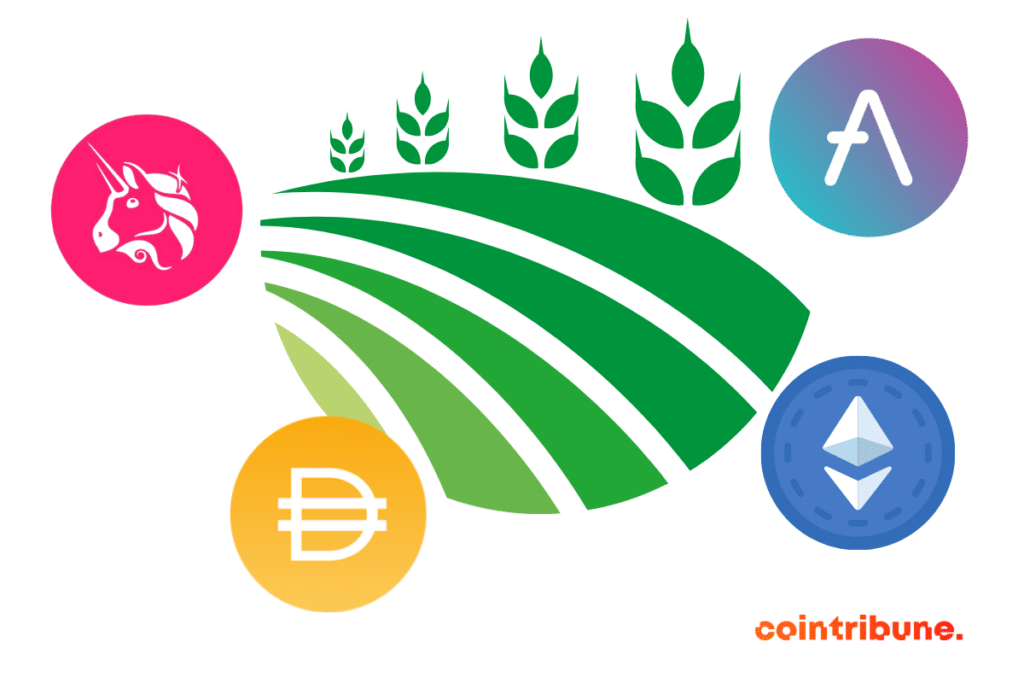What Is Yield Farming In DeFi?
In the rapidly expanding world of decentralized finance (DeFi), Yield Farming emerges as a key strategy, attracting the attention of cryptocurrency investors. This practice, which involves generating passive returns using various cryptocurrencies, is revolutionizing the way digital assets are utilized and managed. However, despite its lucrative potential, Yield Farming carries risks and complexities that should not be underestimated. This article delves into Yield Farming in DeFi, examining its benefits, risks, best practices for beginners, and future prospects in the cryptocurrency ecosystem.

What is Yield Farming?
Yield Farming, a concept at the core of decentralized finance (DeFi), is an innovative strategy that enables crypto asset users to generate passive returns. This practice involves locking cryptocurrencies in a liquidity pool on a DeFi platform. In return, users receive rewards, often in the form of additional tokens. Yield Farming is similar to staking, but it is generally more complex and offers potentially higher returns.
The Benefits of Yield Farming
Yield Farming has transformed the way investors interact with cryptocurrencies. This strategy offers unique benefits, particularly in terms of potential returns, contribution to market liquidity, and incentives for users.
High Return Potential
Yield Farming stands out for its high return potential, thus attracting many investors to the DeFi space. By depositing their assets in liquidity pools on various platforms, users can earn rewards in the form of additional tokens. These rewards are often proportional to the amount and duration of the deposit, offering a lucrative opportunity for those willing to lock in their cryptocurrencies over an extended period.
The returns generated by Yield Farming can vary significantly depending on the protocols and market conditions. Some protocols offer attractive yield rates to attract new users and capitalize on specific assets. These rates can be significantly higher than those of traditional staking methods or other forms of investment in the crypto space, making Yield Farming particularly appealing for investors seeking high returns.
Contribution to Market Liquidity
Another major advantage of Yield Farming is its contribution to the liquidity of DeFi platforms. By depositing their assets in liquidity pools, users help facilitate exchanges and other financial transactions on the platform. This liquidity is crucial for the smooth operation of decentralized exchanges (DEX) and other financial services within the DeFi ecosystem.
Active participation of users in these liquidity pools ensures better price stability and faster transaction execution. This creates a more reliable and efficient environment for all market participants. Additionally, by contributing to liquidity, users help support innovation and growth in the DeFi ecosystem, thus playing a vital role in its development and maturation.
Incentives for Users and Liquidity Providers
Yield Farming also offers attractive incentives for users and liquidity providers. These incentives often come in the form of governance tokens or other rewards that give users some say over the evolution of DeFi protocols. By actively participating in Yield Farming, users not only earn returns but also gain a voice in the governance of the projects they contribute to.
These incentives enhance user engagement and foster a more active and involved community. Having a say in important decisions makes users feel more connected to the projects and more likely to participate in the long term. This creates a virtuous cycle where users are rewarded not only financially but also by a sense of belonging and influence within the DeFi ecosystem.

The Risks of Yield Farming
Yield Farming, while offering opportunities for attractive returns in the decentralized finance (DeFi) space, comes with significant risks that investors must carefully assess.
Volatility and Market Risks
Yield Farming is inherently tied to the volatility of the cryptocurrency market. Rapid price fluctuations can affect the value of assets deposited in liquidity pools, leading to potential losses for investors. This volatility is exacerbated by the fact that many Yield Farming protocols involve crypto assets that, by nature, are subject to unpredictable price changes. Additionally, the phenomenon of impermanent loss is a specific risk associated with liquidity pools, where changes in the ratio of deposited assets can reduce the overall value of the investment compared to holding the assets individually.
Smart Contract Risks
Smart contracts are at the core of the functioning of Yield Farming platforms, but they carry risks. Programming errors or security breaches in these contracts can result in substantial losses. Investors should be aware that even the most reputable platforms are not immune to vulnerabilities. The increasing complexity of Yield Farming strategies also heightens the risk of errors in smart contracts. It is therefore important to prioritize platforms that have undergone rigorous security audits and to stay informed about security updates and patches.
Liquidity Issues and Other Technical Risks
Another aspect to consider is the risk of liquidity. In some cases, liquidity pools may lack sufficient funds, making it difficult for investors to withdraw their assets without incurring losses. Moreover, technical risks such as reliance on oracles for price data and protocol governance decisions can influence the stability and profitability of Yield Farming investments. These factors highlight the importance of a balanced and well-informed approach, where investors must continuously assess the market environment and adjust their strategies accordingly.
How to Get Started with Yield Farming?
Yield Farming is a fascinating component of decentralized finance (DeFi) that is attracting more and more investors to the world of cryptocurrencies. For beginners, it is essential to understand the fundamental steps to effectively embark on this journey. This involves choosing the right platform, understanding Yield Farming strategies, and knowing best practices to minimize risks.
Choosing a Yield Farming Platform
Choosing the right platform is a crucial step to begin Yield Farming. There are numerous DeFi platforms offering Yield Farming services, each with its own characteristics, advantages, and disadvantages. Users should look for reputable, secure, and transparent platforms. It is important to consider factors such as the types of liquidity pools available, yield rates, transaction fees, and platform ease of use.
Beginners should also ensure that the chosen platform supports the cryptocurrencies they own or plan to acquire. It is recommended to start with well-established and widely used platforms in the DeFi ecosystem, as they generally offer a higher level of security and reliability. Moreover, these platforms often provide educational resources and an active community, which can be very helpful for new users.
Understanding Yield Farming Strategies
Once the platform is chosen, it is important to understand the different Yield Farming strategies available. Yield Farming can involve various methods, such as staking tokens, participating in liquidity pools, or using more complex strategies involving lending and borrowing. Each strategy has its own risks and potential returns, and it is important to fully understand them before committing.
Beginners should familiarize themselves with key Yield Farming terms such as APY (Annual Percentage Yield), impermanent loss, and token rewards. It is also advisable to start with simpler strategies and progress to more complex approaches as one gains experience. Additionally, it is important to stay informed about the latest trends and updates in the Yield Farming field, as the DeFi ecosystem evolves rapidly.
Practices to Minimize Risks
Finally, it is important to adopt prudent practices to minimize the risks associated with Yield Farming. This includes diversifying investments, conducting thorough research on different pools and strategies, and understanding the specific risks related to the protocols and assets used. Beginners should avoid investing more than they can afford to lose and be mindful of the inherent volatility in the cryptocurrency market.
It is also wise to monitor market developments and adjust accordingly. For instance, during periods of high volatility, it may be better to opt for less risky Yield Farming strategies. Moreover, it is important to stay updated on security issues and ensure that assets are stored securely, using reliable wallets and taking measures to protect private keys.
The Future of Yield Farming in DeFi
The future of Yield Farming in DeFi looks promising, marked by constant innovation and increasing integration into the digital economy. This practice, which has already transformed the way investors interact with cryptocurrencies, should continue to evolve with the emergence of new, more sophisticated protocols and strategies. However, it faces challenges, particularly in terms of regulation and security. These issues, crucial for the sustainability and legitimacy of Yield Farming, will require sustained attention from DeFi stakeholders to ensure a balanced and sustainable development of this practice within the cryptocurrency ecosystem.
Conclusion
Yield Farming is a dynamic and essential component of decentralized finance, offering attractive yield opportunities while presenting significant challenges. For investors looking to engage in Yield Farming, a deep understanding of the strategies, a rigorous risk assessment, and a careful selection of DeFi platforms are crucial. As the future of Yield Farming promises innovations and increased integration into the cryptocurrency economy, it is imperative to stay informed and cautious in the face of the rapid evolution of this space. Yield Farming continues to shape the DeFi landscape, offering fertile ground for growth and innovation in the cryptocurrency sector.
Maximize your Cointribune experience with our "Read to Earn" program! For every article you read, earn points and access exclusive rewards. Sign up now and start earning benefits.
The Cointribune editorial team unites its voices to address topics related to cryptocurrencies, investment, the metaverse, and NFTs, while striving to answer your questions as best as possible.
The views, thoughts, and opinions expressed in this article belong solely to the author, and should not be taken as investment advice. Do your own research before taking any investment decisions.